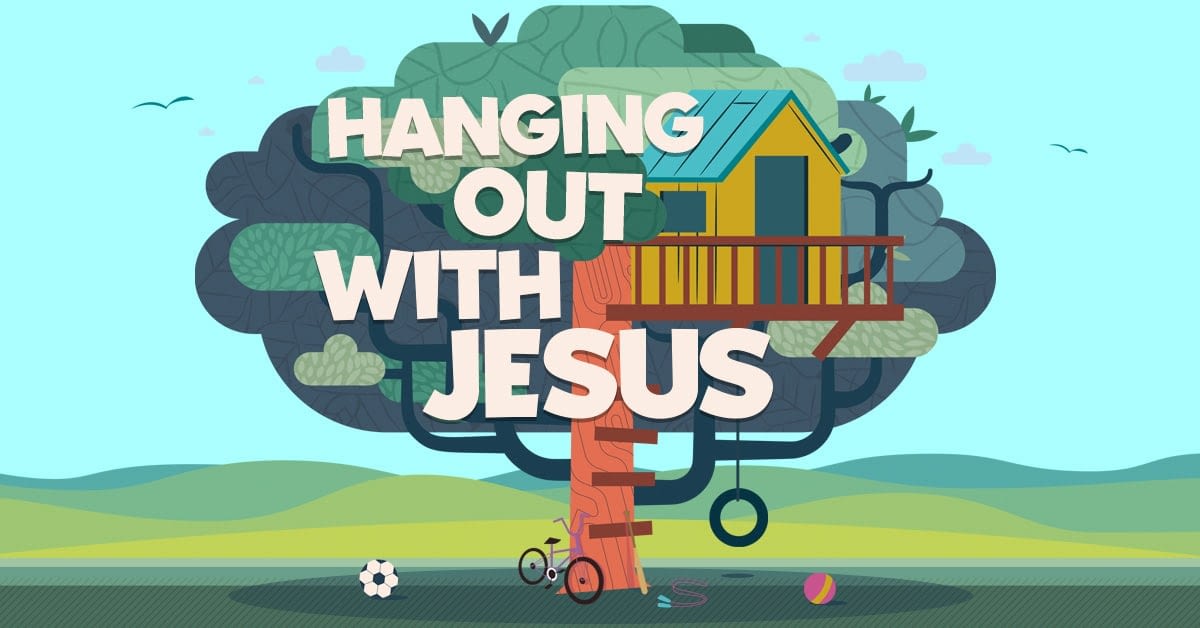As a children’s ministry leader, one of the most important ways of keeping your ministry running smoothly every week is a solid and strong curriculum—one that’s easy to use, Bible-focused, fun and engaging for kids, easy for volunteers to prep and teach, and age appropriate.
It’s important that your curriculum is a right fit for the kids and leaders in your ministry, and choosing, evaluating, and tweaking the right curriculum will bring great value to your children’s ministry.
Curriculum provides a foundation, framework, and strategy for teaching kids to know God and know His big story. It helps ensure your lessons are comprehensive, strategic, and age appropriate. It allows leaders to invest time in people rather than preparation.
Curriculum allows for fun, creative, and engaging lessons to be taught. It allows us to fulfill the Great Commission of making disciples: offering kids opportunities to discover their identity as a child of God and know that they are known by God, loved by Jesus, and led by the Holy Spirit.

How to Choose the Right Curriculum for Children’s Ministry
Should you write your own curriculum? You could! As a children’s pastor, I wanted to write my own and I spent a long time doing this and running myself ragged every week when I realized, as soon as I finished one Sunday’s lesson … the next Sunday was almost here, and it was scramble time again!
After years of feeling worn down coming up with my own lessons, I realized my time as a children’s ministry leader is best spend investing in the most valuable ministry, doing something only I could do in my ministry: investing in people. I discovered freedom and joy in purchasing an already-done curriculum that is customizable and includes way more than I could ever have created on my own.
Offer kids opportunities to discover their identity as a child of God and know that they are known by God, loved by Jesus, and led by the Holy Spirit.
I started spending my time pouring into my leaders and building my teams and loving the kids and families in my ministry. And my children’s ministry began to thrive! Every time you spend writing is time not spent in relationship with people—which is discipleship.
Whether you’re using a curriculum you already love or are looking for a new one, or writing your own, these six steps can help you determine the best curriculum fit for your ministry.
- Determine your needs and what you want.
- Consider and evaluate.
- Get input from leaders and volunteers.
- Choose and implement your curriculum.
- Customize to make it work for your church.
- Gather feedback.
Keep in mind: there is no perfect curriculum. Every curriculum will need to be tweaked at least a little to fit your kids and your context.

Wonder Ink’s 3-year, 52-week children’s ministry curriculum offers kids space to fully find their place in God’s Big Story. Children discover they are Known by God, Loved by Jesus, and Led by the Holy Spirit.
1. Determine Your Needs and What You Want in a Curriculum
Why use curriculum? Why not just wing it? Curriculum gives you a framework and strategy to be intentional with what and how you teach and allows you the freedom to spend your time focusing on ministry and discipleship.
Curriculum should take the pressure off of you and your leaders and give you a foundation of helping your kids grow in their faith, making connections with God, and align their minds and hearts with biblical truth.
Your curriculum should allow kids to encounter and experience God, help kids worship and respond to Him, and help them discover biblical truth. Lessons and takeaways should focus on God and His character, not on us.
We tell Bible stories so that kids of all ages can know God better. As they come to know God through His stories, they will know better how to be in relationship with Him. Our primary goal when teaching any story from the Bible is to explain what the story teaches us about God.
The most important part of the process is asking the Holy Spirit to lead and guide you throughout the process of choosing and implementing the new curriculum.
What’s Important to Your Ministry?
Think about what is important to you and your church. Look at samples of several curriculum lines and compare. You can invite some of your teachers to evaluate them too.
When you’re evaluating, consider your demographic and target? Do you have mostly unchurched kids in your ministry? Are the kids biblically literate? Are your teachers consistent, or rotating? Do you have a Sunday School model or classroom model, rotating model, large group model, all the ages together in one room? Do you need a curriculum that works with kids with special needs? Do you need a curriculum that is light on supplies required for each lesson?
Determine whether you want a curriculum that focuses on behavior and morals or a connecting with God. Do you want a curriculum that teaches kids facts about God or offers opportunities to encounter God and be put in the path of the divine? A solid curriculum will allow kids to have space for curiosity and big questions, without leaving a doubt about who they are in Christ. It should help kids discover their identity in Christ and know God’s big story.
2. Consider and Evaluate
Gather samples and research curriculum. Compare the samples and scope and sequence. If possible, visit churches who are using different curriculum lines.
When you evaluate, don’t just read about the lessons. Dig into the sample lessons and scope and sequence and look thoroughly to see if the content aligns with what the curriculum says it is about.
As you evaluate, think critically and try not to make assumptions that everything you read is biblically and theologically sound and accurate. Don’t just look at what is included in lessons; look at what isn’t included as well.
For example: Does the curriculum include the full gospel? Does it mention sin? Does it miss any major Bible stories or theological foundations? Does it teach Bible stories accurately and within the context of the whole Bible?
We should always teach Bible stories contextualized within the big picture of God’s plan as it is revealed in the Bible. The Bible is God’s self-revelation, enabling the readers to know God more; it is God telling His own story.
It should help kids discover their identity in Christ and know God’s big story.
We have a responsibility when teaching the Word of God, to not abuse it by appropriating it for our own purposes. If we pull things out of context to make the Bible say something it does not and teach with our own behavior, we teach the stories wrongly. A Bible story is told rightly when we can confidently claim that it represents the intention of the author and authority of the text.
Curriculum serves as a bridge between the Scriptures and the kids by illuminating the meaning of the biblical text and helping kids discern its implications for life. Teachers and a solid, biblical curriculum must inform kids’ perspectives in age-appropriate ways but they still must allow Scripture to speak rather than twisting it to say what they want it to say.

Questions to Ask When Evaluating Curriculum for Children’s Ministry
- What is the vision, philosophy, and values of the curriculum? How does the curriculum point to or encompass those things? Do they align with your church?
- Look at the scope and sequence: Scope and sequence is what the curriculum teaches and when it is taught. Is it comprehensive? Does it cover all the major Bible stories? Is it chronological or topical? Are the Bible stories age appropriate? Does it fit with the flow of your teaching calendar and seasonal calendar? How many years does it include? Is it series-based? Does it include Bible stories for the major holidays (Christmas and Easter), or will you have to come up with something on your own for the holidays? Are the Bible stories and main points age appropriate? Does the curriculum fit with the flow of your teaching calendar and seasonal calendar? Does it cover all of the age groups included in your children’s ministry, and are the age groups learning the same Bible stories?
- Is it theme/series driven? If so, are the themes biblical or topical? Do the themes engage kids and help them make connections to God’s big story?
- How is delivered? Digitally or print? Is it editable? If there is something that doesn’t align with your church, can you edit easily? Will it be taught digitally (iPad/phone/computer or printed)? What format do you want and need? Print? Digital? Media-driven? Small group/age based?
- What is the format? Can you adapt it to fit your church’s needs or format? Is it large group/small group or age-based/classroom style, or rotation style? Is it media-driven, or teacher led? Does it include Bible story videos? How important are Bible story videos to your ministry? Are student books or teacher books required? (Personal story of using a curriculum on Sunday morning and reading on Saturday that the main part of the lesson required pre-ordered student books.) Is it totally media-driven (plug and play) or enhanced with media? Are Bible story videos required or are there live teaching scripts?
- Is the curriculum Bible-centered and gospel focused? Do the activities and games point to God and the main point? Does it clearly articulate the Gospel? Is it biblically sound and accurate? Does it align with your church’s views and values?
- Is it fun, engaging, and age appropriate? If you’re teaching the best content in the world, but kids are bored, they will check out. Good curriculum can help you engage the kids and help bring the Bible to life and make it fun for kids. Is it hands-on and does it include experiences for kids? Is it outdated and mundane or fresh and creative?
- Is it easy to use and adapt? Will it be easy to print, prepare, and use each week? Is it easy for your volunteers to adapt? Will it take hours of preparation and editing each week?
- If you had the chance to teach it, were the kids engaged? Did it keep their attention and help them grow in their faith? Did they grow closer to God and discover His big story?
- How does it help you resource parents and volunteers? Does it provide a way for your church to partner with parents and equip them as spiritual leaders? Does the curriculum help you train and equip your volunteers? Is it easy to prepare and hand off to volunteers? Do the volunteers like the curriculum? Will they be able to access it and use it to teach?
- Is it comprehensive? Does it include anything in addition to the lessons, such as events, parent resources, volunteer resources, media, worship, programming or decorating tips? Does it include anything for preschoolers, elementary kids, preteens, kids with special needs? Any extras? Do the extras cost more? If it doesn’t include extras, is your church able to supplement those resources or do without them?
- Does it fit with your church’s theology and teaching? Is it denominational or ecumenical?
- Does it help bring kids closer to Jesus and allow them to experience and connect with Him? Does it just teach facts about God and the Bible or help kids encounter and know God? Does it teach good morals and good behavior or legalistic Christianity or a relationship with Jesus?
3. Get Input from Leaders and Volunteers
Talk with your leaders and supervisors (as well as your volunteers and children’s ministry team leaders) about the new curriculum. Show them samples and a scope and sequence. Ask for feedback and questions. If possible, do a trial run with several different curriculum lines and ask the volunteers which they prefer and what they like about it.
Talk with your team about your church’s needs, your demographic and goals for the kids and families in your ministry, your budget, and your values and vision.
Once you’ve talked through the details of the curriculum, look through the sample lesson or lessons with your leaders who will be using the curriculum. Ensure they’re on board with the chosen new curriculum. If the curriculum involves an online portal, ensure they are comfortable with it and answer any questions they may have.
When your leaders and children’s ministry team is committed and excited, the transition to the new curriculum will go smoothly!
4. Choose and Implement Your Curriculum for Children’s Ministry
Prepare Your Team
Plan a meeting (food is always a plus, if possible!) for your children’s ministry volunteer team to introduce them to the curriculum. Start by introducing the philosophy and values of the curriculum and how it fits with the mission and values of your church and children’s ministry.
If your curriculum offers volunteer training resources, videos, or How-To tutorials, utilize these in this meeting.
If your curriculum is flexible, customizable, and adaptable, you’ll be able to easily tweak it to fit your church and your kids. Empower your volunteers and teachers to adapt it even more to add their own personal touch. Encourage them to look over the curriculum ahead of time when it’s their week to lead, instead of right before the service (or even reading it as they go!).
Let them know the process for accessing the curriculum and the supplies each week: Will they be in charge of securing their own supplies or will you provide them? Is there a fully stocked supply room with a list of every item available? Will they have a pre-prepped basket each week in the volunteer room? If they need to request supplies ahead of time, consider implementing a formal process for requesting supplies with a certain amount of notice before the supplies are needed.
Remind your church of the “why” and the value of children’s ministry.
You could even have a mock service to do a run-through using the curriculum, with some of the leaders acting as students, and others leading the service. This will help your volunteers feel comfortable using and teaching the curriculum.
Ensure they know how to access and use the curriculum and prepare a volunteer schedule so they can see their assigned dates to lead ahead of time.

Plan Your Ministry Year
Once your leader team is on board and your team is trained and prepared, make a schedule for the entire ministry calendar year. Determine the date you will begin using the curriculum and plan your weekend services (as much in advance as you can, according to the curriculum you’ve chosen). Are there themes or series involved in the curriculum? Will you need to order supplies or decorate or promote anything in advance?
Plan the special events you’ll do that year and choose the curriculum or theme you will use for them in advance.
Look for the holidays this year that fall on a weekend service and decide how you will work those into your curriculum: Does the curriculum offer holiday lessons or series? Will you plan a “family service” for those dates?
Look at whether your curriculum provides resources for special events outside of just weekend services. When your ministry is planned, you can begin to prepare and promote, and help your church get excited for what’s coming in the year!
Don’t forget to involve parents. Communicate with parents and let them know what curriculum you’re using and how it will involve and support them. Make a plan for how you will share the Bible stories with them and equip them to disciple their kids at home. Invite them to be a part of the ministry. You can offer a parent meet-up or breakfast to announce and go through the curriculum with them.
Cast Vision
Once you’ve communicated with leaders and volunteers, planned your year, and involved parents, don’t neglect vision casting for the new curriculum and for your children’s ministry.
This is a crucial step for starting a new curriculum: reminding your church of the “why” and the value of children’s ministry. Children’s ministry is not just for teaching kids facts or keeping them occupied: it’s about helping them form a faith identity that is rooted in Scripture and allowing them to connect with God and ask big questions.
Children’s ministry curriculum should do more than just entertain: it should help them live out the gospel in active faith and help them grow as disciples. It should be life-transformational, age-appropriate, and relevant so kids feel valued.
Communicate the vision and value for transformational children’s ministry clearly—and communicate often! Share stories of life change and celebrate how God is working in your children’s ministry.
5. Customize to Make It Work for Your Church
Review the Scope and Sequence, main points, lessons, and videos. If possible, edit the lessons and format to fit your church.
Add your own creativity through videos, worship, games, decorations, themes, and events. Determine whether or how your volunteers will be able to customize their lessons. Allow volunteers to edit and customize the lessons too.
6. Gather Feedback
It’s important to ask for feedback and listen to your team. After you start using the new curriculum, make it easy for parents and volunteers to provide feedback. You can use an email evaluation to ask for feedback or offer a box with cards they can turn in at any time.
Find out what’s working well, what needs to be fixed or tweaked, and what isn’t working. Don’t stop after the first month or two; gather feedback and evaluate continually (at least once a quarter). Continually ask if the curriculum is still working and accomplishing your goals.
The right curriculum for your children’s ministry will lay a foundation for teaching the Bible and allow you to do the personal work of ministry: invest in the people in your ministry.
And when you do all of this, you make space for God to work in the lives of kids and families, and you’ll experience Him work in great ways!
Learn more about Wonder Ink Children’s Curriculum in this article: Top 10 Reasons to Try Wonder Ink Children’s Curriculum for Free.






